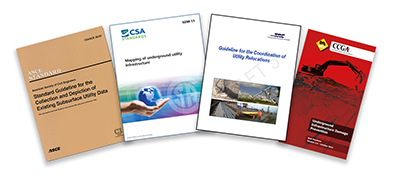Subsurface Utility Engineering is Gaining Momentum Across Canada with Provincial Ministries of Transportation
by Ophir Wainer | T2 Utility Engineers
Professional engineers working on public and private infrastructure projects all too often encounter unexpected costs and delays due to inaccurate or incomplete utility drawings. Many times the responsibility for providing accurate utility information is passed around from utility owner to consultant to contractor. It is not a problem that is unique to Canada — it is common throughout North America and the world. We do not have accurate and reliable utility records that show the exact location of our underground utility infrastructure, and yet this information is crucial for mitigating risks, increasing efficiency, reducing costs and improving safety on constructions projects.
 Subsurface Utility Engineering, or as it is commonly known, SUE, combines traditional civil engineering practices with new technologies to develop reliable and accurate maps of underground utility infrastructure. The SUE process is effectively like setting up a common language that engineers, owners, contractors and utilities can all understand and utilize. SUE is recognized in the American Society of Civil Engineers’ Standard 38-02: Standard Guidelines for the Collection and Depiction of Existing Subsurface Utility Data and in the Canadian Standards Association document S250-11. The intent of the SUE mapping process is to present a unified system for collecting and classifying utility data so that all parties can clearly understand what is being shown on drawings and how that information was collected.
Subsurface Utility Engineering, or as it is commonly known, SUE, combines traditional civil engineering practices with new technologies to develop reliable and accurate maps of underground utility infrastructure. The SUE process is effectively like setting up a common language that engineers, owners, contractors and utilities can all understand and utilize. SUE is recognized in the American Society of Civil Engineers’ Standard 38-02: Standard Guidelines for the Collection and Depiction of Existing Subsurface Utility Data and in the Canadian Standards Association document S250-11. The intent of the SUE mapping process is to present a unified system for collecting and classifying utility data so that all parties can clearly understand what is being shown on drawings and how that information was collected.
The Ministry of Transport across Canada are currently adopting the published TAC “Guideline for the Coordination of Utility Relocations” which promotes the use of ASCE 38-02 Standard early in the Utility Coordination process. A FREE copy of the new TAC guideline can be downloaded from the TAC website.
The main goal of any utility investigation is to mitigate the risk associated with encountering unknown utilities at the time of construction. This includes risk to personal safety, risk to the project schedule, risk to the project budget and more. The investment in a full SUE investigation provides immediate returns measured by the reduction of change orders, reduction in relocation costs, and reduction in schedule delays.
 Subsurface Utility Engineering, or as it is commonly known, SUE, combines traditional civil engineering practices with new technologies to develop reliable and accurate maps of underground utility infrastructure. The SUE process is effectively like setting up a common language that engineers, owners, contractors and utilities can all understand and utilize. SUE is recognized in the American Society of Civil Engineers’ Standard 38-02: Standard Guidelines for the Collection and Depiction of Existing Subsurface Utility Data and in the Canadian Standards Association document S250-11. The intent of the SUE mapping process is to present a unified system for collecting and classifying utility data so that all parties can clearly understand what is being shown on drawings and how that information was collected.
Subsurface Utility Engineering, or as it is commonly known, SUE, combines traditional civil engineering practices with new technologies to develop reliable and accurate maps of underground utility infrastructure. The SUE process is effectively like setting up a common language that engineers, owners, contractors and utilities can all understand and utilize. SUE is recognized in the American Society of Civil Engineers’ Standard 38-02: Standard Guidelines for the Collection and Depiction of Existing Subsurface Utility Data and in the Canadian Standards Association document S250-11. The intent of the SUE mapping process is to present a unified system for collecting and classifying utility data so that all parties can clearly understand what is being shown on drawings and how that information was collected.